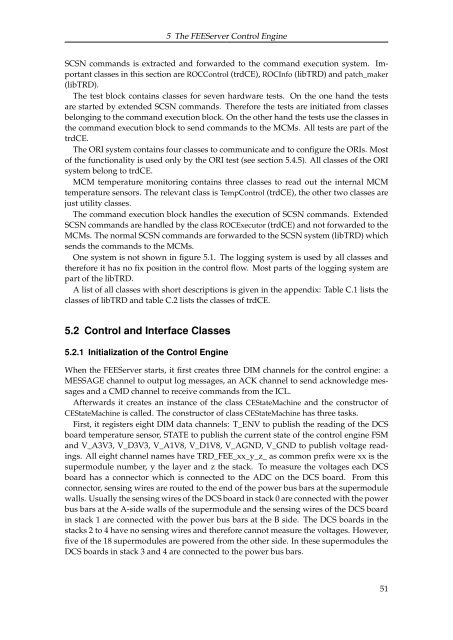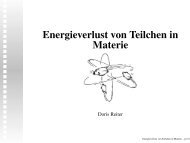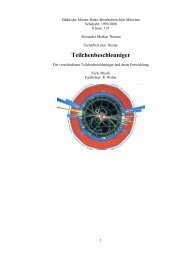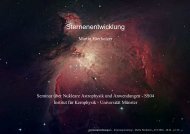The FEE Server Control Engine of the ALICE-TRD - Westfälische ...
The FEE Server Control Engine of the ALICE-TRD - Westfälische ...
The FEE Server Control Engine of the ALICE-TRD - Westfälische ...
Create successful ePaper yourself
Turn your PDF publications into a flip-book with our unique Google optimized e-Paper software.
5 <strong>The</strong> <strong>FEE</strong><strong>Server</strong> <strong>Control</strong> <strong>Engine</strong><br />
SCSN commands is extracted and forwarded to <strong>the</strong> command execution system. Important<br />
classes in this section are ROC<strong>Control</strong> (trdCE), ROCInfo (lib<strong>TRD</strong>) and patch_maker<br />
(lib<strong>TRD</strong>).<br />
<strong>The</strong> test block contains classes for seven hardware tests. On <strong>the</strong> one hand <strong>the</strong> tests<br />
are started by extended SCSN commands. <strong>The</strong>refore <strong>the</strong> tests are initiated from classes<br />
belonging to <strong>the</strong> command execution block. On <strong>the</strong> o<strong>the</strong>r hand <strong>the</strong> tests use <strong>the</strong> classes in<br />
<strong>the</strong> command execution block to send commands to <strong>the</strong> MCMs. All tests are part <strong>of</strong> <strong>the</strong><br />
trdCE.<br />
<strong>The</strong> ORI system contains four classes to communicate and to configure <strong>the</strong> ORIs. Most<br />
<strong>of</strong> <strong>the</strong> functionality is used only by <strong>the</strong> ORI test (see section 5.4.5). All classes <strong>of</strong> <strong>the</strong> ORI<br />
system belong to trdCE.<br />
MCM temperature monitoring contains three classes to read out <strong>the</strong> internal MCM<br />
temperature sensors. <strong>The</strong> relevant class is Temp<strong>Control</strong> (trdCE), <strong>the</strong> o<strong>the</strong>r two classes are<br />
just utility classes.<br />
<strong>The</strong> command execution block handles <strong>the</strong> execution <strong>of</strong> SCSN commands. Extended<br />
SCSN commands are handled by <strong>the</strong> class ROCExecutor (trdCE) and not forwarded to <strong>the</strong><br />
MCMs. <strong>The</strong> normal SCSN commands are forwarded to <strong>the</strong> SCSN system (lib<strong>TRD</strong>) which<br />
sends <strong>the</strong> commands to <strong>the</strong> MCMs.<br />
One system is not shown in figure 5.1. <strong>The</strong> logging system is used by all classes and<br />
<strong>the</strong>refore it has no fix position in <strong>the</strong> control flow. Most parts <strong>of</strong> <strong>the</strong> logging system are<br />
part <strong>of</strong> <strong>the</strong> lib<strong>TRD</strong>.<br />
A list <strong>of</strong> all classes with short descriptions is given in <strong>the</strong> appendix: Table C.1 lists <strong>the</strong><br />
classes <strong>of</strong> lib<strong>TRD</strong> and table C.2 lists <strong>the</strong> classes <strong>of</strong> trdCE.<br />
5.2 <strong>Control</strong> and Interface Classes<br />
5.2.1 Initialization <strong>of</strong> <strong>the</strong> <strong>Control</strong> <strong>Engine</strong><br />
When <strong>the</strong> <strong>FEE</strong><strong>Server</strong> starts, it first creates three DIM channels for <strong>the</strong> control engine: a<br />
MESSAGE channel to output log messages, an ACK channel to send acknowledge messages<br />
and a CMD channel to receive commands from <strong>the</strong> ICL.<br />
Afterwards it creates an instance <strong>of</strong> <strong>the</strong> class CEStateMachine and <strong>the</strong> constructor <strong>of</strong><br />
CEStateMachine is called. <strong>The</strong> constructor <strong>of</strong> class CEStateMachine has three tasks.<br />
First, it registers eight DIM data channels: T_ENV to publish <strong>the</strong> reading <strong>of</strong> <strong>the</strong> DCS<br />
board temperature sensor, STATE to publish <strong>the</strong> current state <strong>of</strong> <strong>the</strong> control engine FSM<br />
and V_A3V3, V_D3V3, V_A1V8, V_D1V8, V_AGND, V_GND to publish voltage readings.<br />
All eight channel names have <strong>TRD</strong>_<strong>FEE</strong>_xx_y_z_ as common prefix were xx is <strong>the</strong><br />
supermodule number, y <strong>the</strong> layer and z <strong>the</strong> stack. To measure <strong>the</strong> voltages each DCS<br />
board has a connector which is connected to <strong>the</strong> ADC on <strong>the</strong> DCS board. From this<br />
connector, sensing wires are routed to <strong>the</strong> end <strong>of</strong> <strong>the</strong> power bus bars at <strong>the</strong> supermodule<br />
walls. Usually <strong>the</strong> sensing wires <strong>of</strong> <strong>the</strong> DCS board in stack 0 are connected with <strong>the</strong> power<br />
bus bars at <strong>the</strong> A-side walls <strong>of</strong> <strong>the</strong> supermodule and <strong>the</strong> sensing wires <strong>of</strong> <strong>the</strong> DCS board<br />
in stack 1 are connected with <strong>the</strong> power bus bars at <strong>the</strong> B side. <strong>The</strong> DCS boards in <strong>the</strong><br />
stacks 2 to 4 have no sensing wires and <strong>the</strong>refore cannot measure <strong>the</strong> voltages. However,<br />
five <strong>of</strong> <strong>the</strong> 18 supermodules are powered from <strong>the</strong> o<strong>the</strong>r side. In <strong>the</strong>se supermodules <strong>the</strong><br />
DCS boards in stack 3 and 4 are connected to <strong>the</strong> power bus bars.<br />
51







